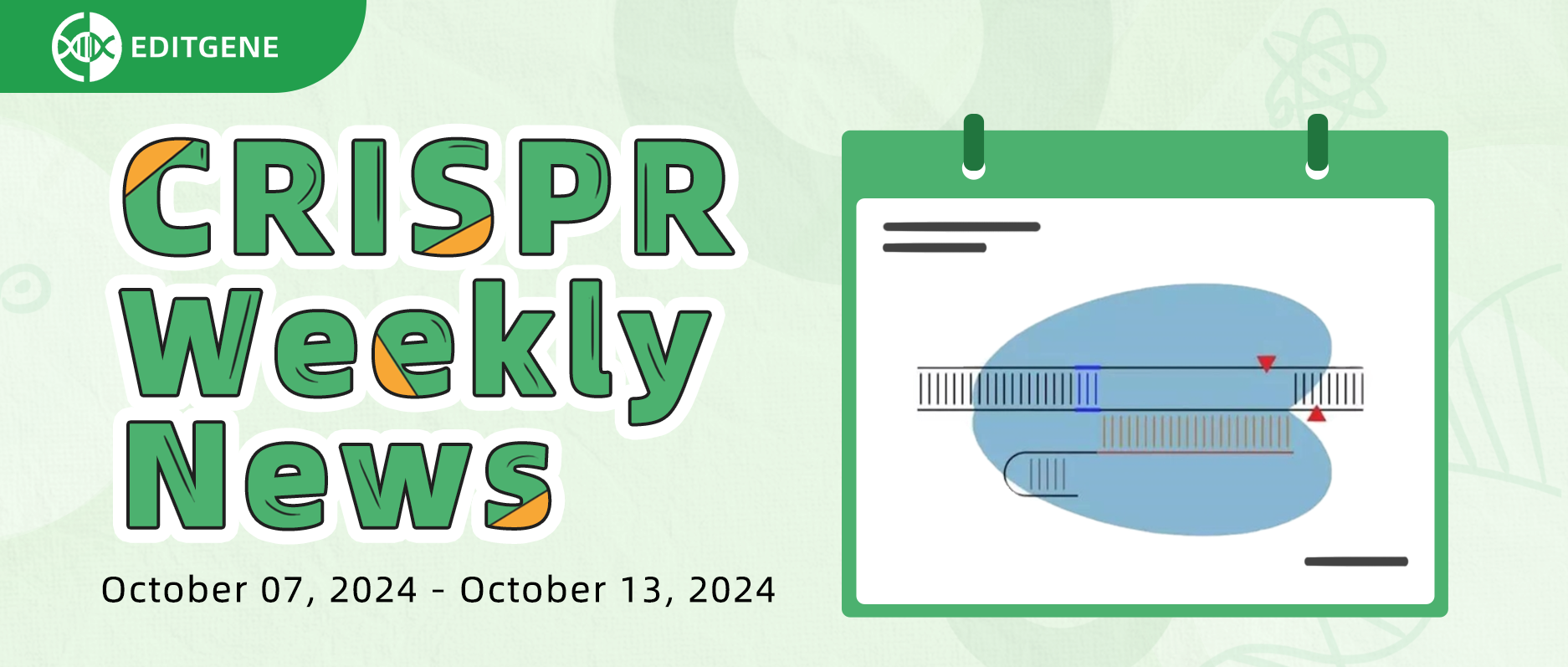[Weekly News] Breakthrough gRNA Algorithm Supercharges CRISPR Detection Sensitivity

CRISPR/Cas technology is a revolutionary tool in modern biological sciences, with applications spanning medicine, agriculture, environmental conservation, and more. New findings and case studies continue to emerge across these fields. Our 'CRISPR Weekly News' column brings you the latest research and industry updates. Here's a brief summary of the past week's highlights:
I. Research Updates
i. CRISPR Screening
1. Title: Crispr-mediated genome editing reveals a preponderance of non-oncogene addictions as targetable vulnerabilities in pleural mesothelioma
Journal: Lung Cancer (Impact Factor: 4.5)
Original Link: https://doi.org/10.1016/j.lungcan.2024.107986
Pleural mesothelioma (PM) is a malignant cancer with limited treatment options, particularly due to frequent loss of tumor suppressor genes. Researchers conducted CRISPR/Cas9 knockout screening on two histologically distinct PM cell lines, JL-1 and msto211h, identifying genetic alterations. The screening revealed key insights into non-oncogene dependencies, particularly the role of NF2 in restoring cell function in lats2-mutant PM cells, offering a blueprint for developing novel therapies.
2. Title: Transcriptional inhibition after irradiation occurs preferentially at highly expressed genes in a manner dependent on cell cycle progression
Journal: eLIFE (Impact Factor: 6.4)
Original Link: https://doi.org/10.7554/eLife.94001
Researchers investigated the transcriptional response to ionizing radiation (IR) and found that transcriptional recovery after DNA damage is independent of HIRA. Using genome-wide gRNA libraries for CRISPR/Cas9 screening, they identified several factors linked to neddylation that mediate IR-induced transcriptional repression, which predominantly affects highly expressed genes in cycling cells.
ii. CRISPR Knockout Cell Lines
1. Title: Gene editing of NCF1 loci is associated with homologous recombination and chromosomal rearrangements
Journal: Communications Biology (Impact Factor: 5.2)
Original Link: https://doi.org/10.1038/s42003-024-06959-z
Researchers used CRISPR/Cas to edit NCF1 and its pseudogenes (NCF1B and NCF1C) in human cell models of p47-phox deficient chronic granulomatous disease (p47 CGD). They detected megabase-scale rearrangements, revealing that such rearrangements stem from interactions between repeat sequences. This highlights the importance of considering genomic background in gene editing for pseudogene-associated diseases.
2. Title: CRISPR-edited human ES-derived oligodendrocyte progenitor cells improve remyelination in rodents
Journal: Nature Communications (Impact Factor: 14.7)
Original Link: https://doi.org/10.1038/s41467-024-52444-w
In multiple sclerosis (MS), chronic demyelination leads to neurodegeneration and disability. Researchers used CRISPR gene editing to modify human embryonic stem cell-derived oligodendrocyte progenitor cells (hOPCs), making them resistant to inhibitory factors released in chronic MS lesions. When transplanted into rodent models, these edited hOPCs showed enhanced remyelination, offering a potential treatment for progressive MS.
iii. CRISPR Detection
1. Title: Model-directed generation of artificial CRISPR-Cas13a guide RNA sequences improves nucleic acid detection
Journal: Nature Biotechnology (Impact Factor: 33.1)
Original Link: https://doi.org/10.1038/s41587-024-02422-w
CRISPR-Cas13a is widely used in RNA virus detection. Researchers employed machine learning models to generate optimized gRNA sequences, significantly improving nucleic acid detection sensitivity and specificity. These artificial gRNA sequences outperformed traditional designs in detecting low-concentration targets, providing a promising avenue for enhancing CRISPR-based diagnostics.
2. Title: Harnessing noncanonical trans-cleavage characteristics of Cas12 and Cas13a to enhance CRISPR-based diagnostics
Journal: Communications Biology (Impact Factor: 5.2)
Original Link: https://doi.org/10.1038/s42003-024-07000-z
Cas12 and Cas13 are widely used in molecular diagnostics for their trans-cleavage activity, though their activation mechanisms remain unclear. Researchers explored Cas12a, Cas12f1, and Cas13a, discovering their trans-DNase and trans-RNase activities. DNA can directly activate CRISPR-Cas13a, improving single-base mismatch detection. Cas12a and Cas13a are activated by distinct RNA and RNA duplexes, while Cas12f1 shows intrinsic RNase activity without activation. These insights enhance dual-gene target detection accuracy and deepen the understanding of noncanonical activation in CRISPR-based diagnostics.
iv. Other CRISPR-Related Research
1. Title: Novel deoxyhypusine synthase (DHPS) inhibitors target hypusination-induced vasculogenic mimicry (VM) against malignant melanoma
Journal: Pharmacological Research (Impact Factor: 9.1)
Original Link: https://doi.org/10.1016/j.phrs.2024.107453
Vasculogenic mimicry (VM) contributes to poor prognosis in malignant melanoma, making DHPS inhibitors a valuable therapeutic target. Researchers identified compound 7k through screening, which effectively targeted DHPS both in vitro and in vivo. Point mutations at K329 or V129 in DHPS abolished 7k's activity, confirming its high specificity. Further analysis revealed that DHPS promotes melanoma VM by regulating FGFR2 and c-KIT expression, highlighting 7k’s potential as a novel anti-melanoma drug.
2. Title: Ubiquitin-specific peptidase 25 ameliorates hepatic steatosis by stabilizing peroxisome proliferator activated receptor alpha
Journal: Journal of Biological Chemistry (Impact Factor: 4)
Original Link: https://doi.org/10.1016/j.jbc.2024.107876
USP25 was shown to play a role in non-alcoholic fatty liver disease (NAFLD) by stabilizing PPARα. Researchers found that knocking down USP25 exacerbated fatty liver in cells and mouse models, while overexpressing USP25 ameliorated fatty degeneration. USP25 inhibitors worsened diet-induced steatosis, suggesting USP25 as a potential therapeutic target for NAFLD.
II. Industry News
1. HuidaGene Therapeutics announced this week that it will present 11 talks at the upcoming 2024 European Society of Gene and Cell Therapy (ESGCT) Annual Meeting in Rome later this month. The presentations, including 10 posters and 1 oral talk, will showcase the company's advancements in gene editing therapies, covering conditions such as age-related macular degeneration, MECP2 duplication syndrome, Alzheimer's, ALS, Huntington's disease, Angelman syndrome, and Duchenne muscular dystrophy.
News Link: https://www.huidagene.com/new/news/67
2. ProQR Therapeutics announced earlier this week that it will present its proprietary Axiomer™ RNA editing technology platform at the 20th Annual Meeting of the Oligonucleotide Therapeutics Society, held in Montreal, Quebec, Canada. The presentation will include preclinical data from its AX-0810 pipeline program, which targets NTCP (sodium taurocholate co-transporting polypeptide) for the treatment of cholestatic diseases.
3. Editas Medicine recently announced the sale of a portion of future licensing fees and other payments owed under its Cas9 licensing agreement with Vertex Pharmaceuticals to a subsidiary of DRI Healthcare Trust. The upfront cash payment of $57 million will provide non-dilutive capital to support Editas Medicine's product development and strategic priorities.
EDITGENE focuses on CRISPR technology, offering a range of high-quality gene editing services and in vitro diagnostic products.
These include but are not limited to: CRISPR Library Screening, Cell Line Engineering, Monoclonal Cell Line Screening, CRISPR Detection.
We are committed to providing the most efficient technical services for CRISPR-related, gene function research, in vitro diagnostics, and therapeutic research.
Recent Blogs:
1.[Literature Review] CRISPR Screening Reveals Aging Regulators in Neural Stem Cells
Follow us on social media
Contact us
+ 833-226-3234 (USA Toll-free)
+1-224-345-1927 (USA)
info@editxor.com









![[Weekly News] Breakthrough gRNA Algorithm Supercharges CRISPR Detection Sensitivity](/uploads/20241025/jZWvb6nz50H8yACQ_ce9a01bd08f9d18c7d09fad585bc559f.jpg)

Comment (4)